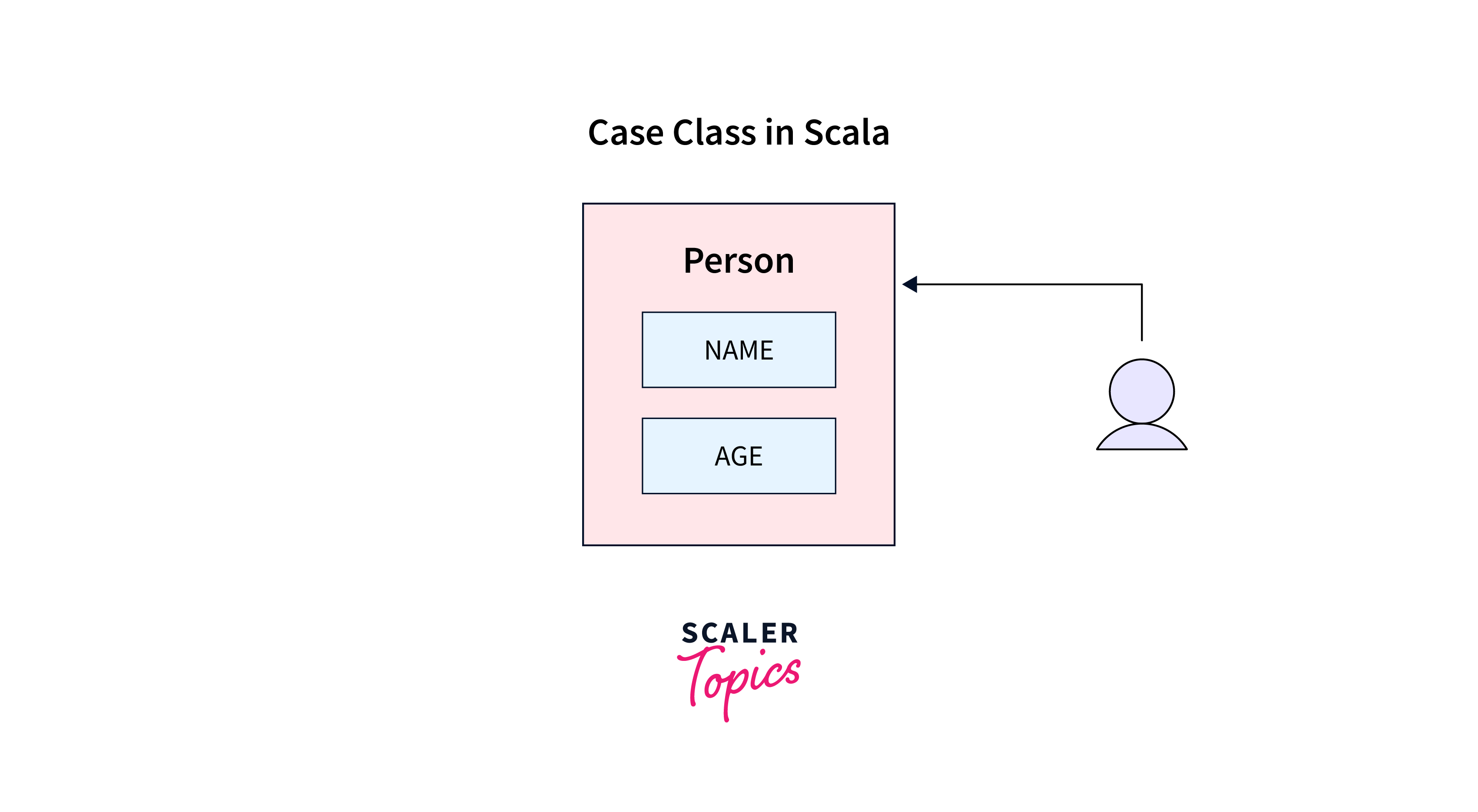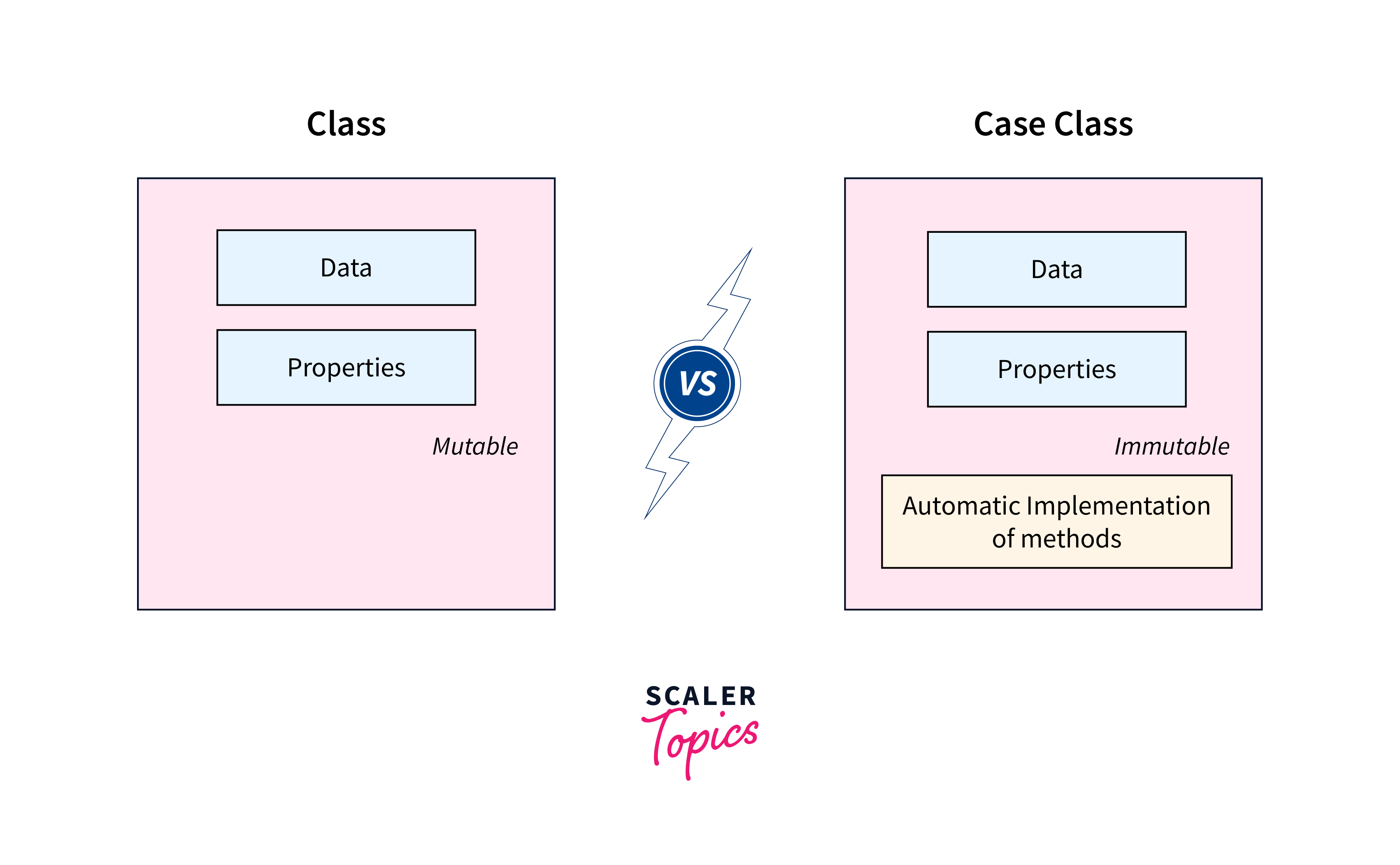Scala Case Class
Overview
Case class in Scala is a special type of class that is primarily used for modeling immutable data structures. It provides a concise way to define classes with minimal boilerplate code, as many common methods (like equality, hashing, and a default toString implementation) are automatically generated by the compiler. Case classes are often used for representing data objects, such as records or value objects.
Defining a Case Class
Case class in Scala is a fundamental building block for creating immutable data structures and is particularly useful for modeling data objects, records, or value objects.
In Scala, a case class is a powerful tool for creating and managing data-packed objects effortlessly. It automates crucial tasks like object comparison, clean printing, and data immutability, making it ideal for representing entities such as people or graph points, streamlining data organization.
Syntax
A case class is defined using the case class keyword followed by the class name and a parameter list. Each parameter defines a property of the class.
Syntax:
We can optionally extend a parent class or trait if needed while defining the case class in Scala.

Scala Case Class Example
Let us see an example to understand case class in Scala:
In this example:
- We defined a case class called Point with two parameters, x and y, both of type Int, representing 2D plane coordinates.
- Inside the main method of the CaseClassDemo object, we created two Point instances using the constructor with specified x and y values, like Point(x, y).
- We printed the points using println. As Point is a case class, it automatically invokes the toString method for clean printing.
- We checked if the two Point instances are equal using ==. Case classes handle this comparison correctly by comparing the contents of the points for equality.
- We accessed the fields of a case class instance using dot notation, such as point1.x and point1.y.
- We employed pattern matching to compare a point with a specific pattern, like Point(2, y), and print the y-coordinate if the pattern matches.
Comparison between Class and Case Class
Here's a comparison between classes and case classes in Scala:
| Aspect | Class | Case Class |
|---|---|---|
| Boilerplate Code | Requires manual implementation of equals, hashCode, and toString. | Automatically generates equals, hashCode, and a default toString method. |
| Immutability | Classes are mutable by default, meaning we can change their properties after instantiation. | Case classes are immutable by default, preventing accidental changes to their properties and enhancing data consistency. |
| Constructor | Manually define constructor parameters and getter methods. | Automatically define constructor parameters as immutable fields with autogenerated getter methods. |
| Pattern Matching | Pattern matching is possible but requires custom unapply methods. | Designed for easy pattern matching with autogenerated extraction. |
| Equality Comparison | Default equals based on reference equality (object identity). | Provides structural equality based on property values. |
| Instantiation | We need to use the new keyword to create instances of regular classes. | We can create instances of case classes without using the new keyword, using a more concise syntax. |
| Extending Behavior | Suitable for custom behavior and methods. | Best for simple data modeling and representation. |
| Identity vs. Value | Often represents objects with identity. | Often represents values and equal instances have the same property values. |

Copying
In Scala, we can create a copy of a case class instance with modified or unchanged values using the copy method. The copy method generates a new instance of the case class with the specified changes while keeping the other fields unchanged.
Here's how we can use the copy method:
- In this example, we have defined a case class Person with two properties: name and age. We then create an instance person1 with the name "Virat" and age 30.
- We use the copy method to create a new instance person2 based on person1 with a modified age. The syntax person1.copy(age = 31) creates a copy of person1 with the age changed to 31.
Some Benefits of Case Class/Object
Case class in Scala offer several compelling benefits that make them a powerful tool for data modeling and manipulation:
-
Immutability:
It is designed to be immutable by default. This ensures that once an instance is created, its properties cannot be changed, promoting data integrity and predictable behavior.
-
Automatic Method Generation:
It automatically generates common methods such as equals, hashCode, and a default toString implementation. This simplifies equality comparisons, hashing, and object representation.
-
Pattern Matching:
It is particularly suited for pattern matching, a powerful feature in Scala. They enable concise extraction and manipulation of data within different cases and scenarios.
-
Copy Method:
The built-in copy method allows us to create modified copies of case class instances while preserving the original. This aids in creating variations of data without altering the source.
-
Reduced Boilerplate:
By automatically generating methods and providing default behavior, case classes reduce the need for repetitive boilerplate code, making codebases cleaner and more maintainable.
Best Practices
-
Use Case Classes for Data Modeling:
Reserve case classes for modeling data structures, records, and value objects. For classes with behavior or methods, consider using regular classes or traits.
-
Keep Properties Immutable:
Ensure that the properties of our case class remain immutable. This prevents unexpected changes and helps maintain data consistency.
-
Leverage Pattern Matching:
Explore the power of pattern matching to handle different cases and scenarios efficiently. Pattern matching can simplify complex branching logic in your code.
Conclusion
- Case class in Scala is a concise construct for defining immutable data structures, automatically generating common methods like equality, hashing, and toString, and seamlessly integrating with pattern matching. It is ideal for modeling records, value objects, and data-centric concepts.
- A class in Scala requires manual implementation of common methods and is mutable by default, while a case class in Scala generates methods like equals, hashCode, and toString automatically, is immutable by default, and excels at concise data modeling.
- Copying in Scala refers to creating a new instance of an object with some values modified while others remain unchanged.
- Case classes promote clean and readable code. By eliminating the need for writing repetitive boilerplate code, they allow us to focus on the actual logic of their applications.
- Case classes work seamlessly with Scala's collection libraries, making it easy to create collections of homogeneous data objects.
